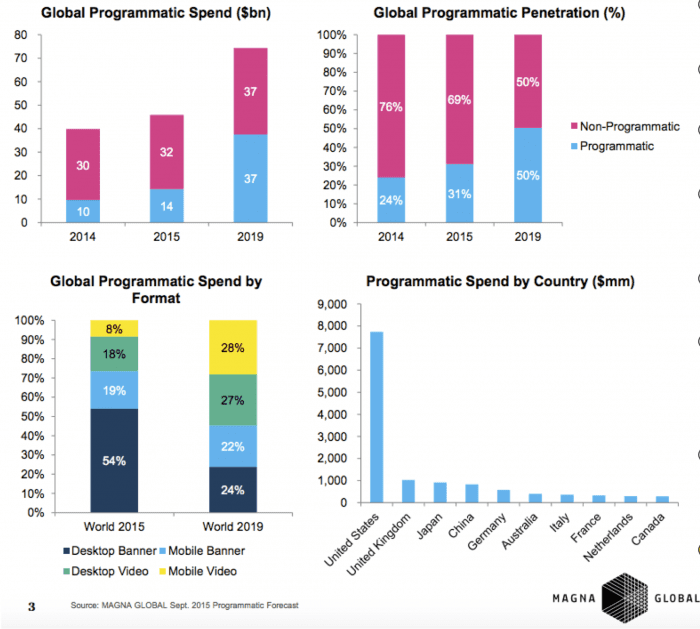What is Programmatic Marketing?


Widely tipped to be the future of digital advertising, how is programmatic marketing defined and what are the opportunities?
Programmatic marketing is seen as the future of advertising on the web, with Google targeting 60% of digital advertising budgets spent on Programmatic by next year. According to a report from Forrester, programmatic will account for the majority of all digital advertising spending with the next few years. The only thing standing in the way of this change is that marketers lack of knowledge of the process and reluctance to give up previous ways of purchasing ads in favour of the complex yet extremely effective instant, automated bidding process used in programmatic marketing. A little knowledge can go a long way, so we thought an introduction to the concept of programmatic marketing would be useful for digital marketers.
This post covers just a handful of the benefits and potential opportunities of programmatic marketing. For a more in-depth look at what programmatic marketing is, the potential benefits, and how to get started with programmatic, see our new guide for all members.
Download free resource – Programmatic Marketing Brief
Learn the key questions to ask when managing Programmatic.
Access the Programmatic Marketing Briefing
Forecasts for Programmatic Marketing
The Magna Global Programmatic Intelligence report gives forecasts for programmatic by format from 2014 to 2019. They estimate that by 2019 it will be 50% of all advertising, which is less than the Forrester estimate, but a significant growth from now.
Defining Programmatic Marketing
Because it involves millisecond long auctions during page loading times via algorithms, programmatic marketing can at first glance seem a baffling concept, but when boiled down to its simplest form it is in essence quite simple. We define Programmatic Marketing as:
Programmatic marketing is automated bidding on advertising inventory in real time, for the opportunity to show an ad to a specific customer, in a specific context.
‘Programmatic Marketing’ or advertising is a general term, so it’s best to divide it based on whether it involves Real-time Bidding (RTB) or not. Often it is only considered to be real-time transactions to bid This summary, also from the Magna Global report is useful to show the differences.
How does it work?
When anyone clicks on a web page that has advertising space on that is configured for programmatic advertising, the publisher of the page puts up an ad impression for auction in an ad marketplace. The ad marketplace then runs an auction among advertisers interested in displaying an ad to that specific customer that just click on the page. There may be many advertisers competing in this auction, and whichever one ultimately is willing to bid the most wins the auction and then their ad is displayed to the customer when the page loads. Because the process is automated and the maximum price each advertiser is willing to bid for the impression has already been programmed in, the auction can be completed within the milliseconds it takes for the page to load. Our simple infographic takes you through 6 steps that explain how programmatic marketing works.
What are the advantages?
Programmatic marketing opens up a series of opportunities, which would not be possible if ad placement was done manually as it has been done in the past. It allows advertisers to procure digital media without having to pre-negotiate a price, so they pay only for the relevant impression that they actually receive. They can also sign up for a minimum number of impressions or a minimum budget, which makes digital advertising more flexible, and they can buy digital media across publishers, which reduced administration costs.
But the opportunities are much greater than just making ad buying easier and more flexible. Because programmatic marketing means bids are arranged for each individual accessing the site people can be targeted to a far greater extent that before.
Using customer data, Programmatic technology can identify what resonates with each individual and target him or her on the sites on the sites they are most likely to engage with and at the time they are most likely to engage. This is why customer data is becoming so highly valued (one of many reasons), and why programmatic advertising is growing so fast- it is projected to become where the majority of non-search digital ad spending goes by the end of 2015.
From our sponsors: What is Programmatic Marketing?




